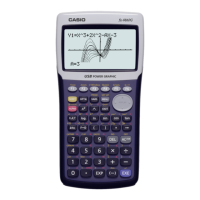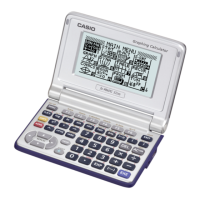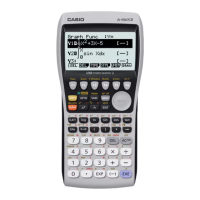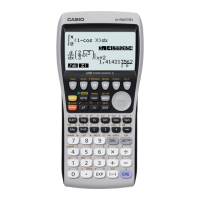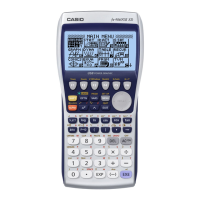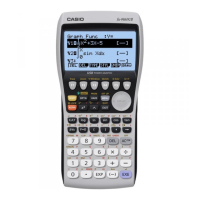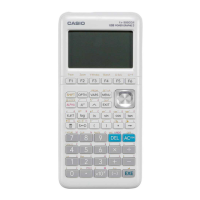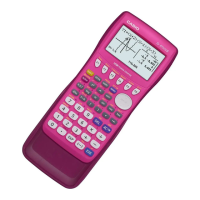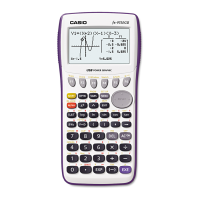Do you have a question about the Casio FX-9860G SD and is the answer not in the manual?
Details the primary and combined functions of each calculator key.
Explains how to select icons, interpret normal and special display formats.
Covers entering, editing, copying, pasting calculations, and using the catalog.
Guides on accessing and modifying settings for different calculator modes.
Provides solutions for common problems like hang-ups and low battery warnings.
Explains arithmetic operations, display settings, and error handling.
Covers calculations using variables, memory, function memory, answer, and history.
Guides on setting angle units (Deg, Rad, Gra) and display formats (Fix, Sci, Norm, Eng).
Covers calculations and conversions between binary, octal, decimal, and hexadecimal number systems.
Details inputting, editing, arithmetic operations, and analysis of matrices.
Explains solving simultaneous linear equations with 2 to 6 unknowns.
Covers solving quadratic and cubic equations by inputting coefficients.
Explains determining variable values in a formula without solving the equation.
Provides examples for drawing simple graphs, conic sections, and using line styles.
Covers V-Window settings, zoom, and specifying graph ranges.
Details specifying graph types, storing functions, editing, and creating composite functions.
Covers generating and editing number tables using ranges or lists.
Explains defining coefficient ranges to observe graph changes and simulating phenomena.
Covers reading coordinates, displaying derivatives, calculating roots, intersections, integrals, and conic section properties.
Explains entering STAT mode, inputting data, and changing graph parameters.
Covers NPP, Histograms, Med-box, Normal Distribution, and Broken Line graphs.
Details scatter diagrams, xy line graphs, and various regression graphs.
Explains Z Tests, t Tests, χ2 Test, F Test, and ANOVA procedures.
Covers Z Intervals and t Intervals for population means and proportions.
Explains Normal, Student-t, χ2, F, Binomial, Poisson, and Geometric distributions.
Introduces TVM mode, financial screens, and setup items like Payment and Date Mode.
Explains formulas and calculations for simple interest.
Covers compound interest formulas, nominal to effective rate conversion, and inputting parameters.
Explains DCF method for NPV, NFV, IRR, and PBP calculations.
Covers creating, inputting, and running programs, including file naming.
Explains debugging, eliminating bugs, and using existing programs to create new ones.
A comprehensive reference for programming commands like If-Then, For-Next, Goto-Lbl.
Provides examples of pre-written programs for tasks like prime factorization and sequence analysis.
Introduces the S•SHT mode, screen configuration, and function menus.
Covers creating, opening, deleting files, and recalculating formulas in spreadsheets.
Explains cell cursor movement, selection, and basic operations.
Details basic cell input, formula input, cell references, and sorting data.
Explains performing statistical calculations and regression analysis on spreadsheet data.
Introduces eActivities, using e•ACT mode, file operations, and workspace screens.
Covers using text lines, math lines, stop lines, strips, and inserting/editing data.
Explains calling up and using Matrix and List Editors within eActivities.
Guides on accessing the SYSTEM mode and its main menu items.
Covers contrast adjustment, APO settings, and system language settings.
Details how to initialize setup, clear memory, or format the SD card.
Explains connecting two calculators using the link cable.
Guides on connecting the calculator to a PC using a USB cable and FA-124 software.
Outlines important precautions and error checks during data transfer.
Covers managing main memory, storage memory, SD card, backing up, and optimizing memory.
Provides instructions for inserting and removing SD cards.
Details important precautions for using SD cards, including recommended types.
Lists common error messages, their meanings, and countermeasures.
An alphabetical and functional reference for all calculator keys and their uses.
Information on battery types, replacement, and auto power-off function.
Details the primary and combined functions of each calculator key.
Explains how to select icons, interpret normal and special display formats.
Covers entering, editing, copying, pasting calculations, and using the catalog.
Guides on accessing and modifying settings for different calculator modes.
Provides solutions for common problems like hang-ups and low battery warnings.
Explains arithmetic operations, display settings, and error handling.
Covers calculations using variables, memory, function memory, answer, and history.
Guides on setting angle units (Deg, Rad, Gra) and display formats (Fix, Sci, Norm, Eng).
Covers calculations and conversions between binary, octal, decimal, and hexadecimal number systems.
Details inputting, editing, arithmetic operations, and analysis of matrices.
Explains solving simultaneous linear equations with 2 to 6 unknowns.
Covers solving quadratic and cubic equations by inputting coefficients.
Explains determining variable values in a formula without solving the equation.
Provides examples for drawing simple graphs, conic sections, and using line styles.
Covers V-Window settings, zoom, and specifying graph ranges.
Details specifying graph types, storing functions, editing, and creating composite functions.
Covers generating and editing number tables using ranges or lists.
Explains defining coefficient ranges to observe graph changes and simulating phenomena.
Covers reading coordinates, displaying derivatives, calculating roots, intersections, integrals, and conic section properties.
Explains entering STAT mode, inputting data, and changing graph parameters.
Covers NPP, Histograms, Med-box, Normal Distribution, and Broken Line graphs.
Details scatter diagrams, xy line graphs, and various regression graphs.
Explains Z Tests, t Tests, χ2 Test, F Test, and ANOVA procedures.
Covers Z Intervals and t Intervals for population means and proportions.
Explains Normal, Student-t, χ2, F, Binomial, Poisson, and Geometric distributions.
Introduces TVM mode, financial screens, and setup items like Payment and Date Mode.
Explains formulas and calculations for simple interest.
Covers compound interest formulas, nominal to effective rate conversion, and inputting parameters.
Explains DCF method for NPV, NFV, IRR, and PBP calculations.
Covers creating, inputting, and running programs, including file naming.
Explains debugging, eliminating bugs, and using existing programs to create new ones.
A comprehensive reference for programming commands like If-Then, For-Next, Goto-Lbl.
Provides examples of pre-written programs for tasks like prime factorization and sequence analysis.
Introduces the S•SHT mode, screen configuration, and function menus.
Covers creating, opening, deleting files, and recalculating formulas in spreadsheets.
Explains cell cursor movement, selection, and basic operations.
Details basic cell input, formula input, cell references, and sorting data.
Explains performing statistical calculations and regression analysis on spreadsheet data.
Introduces eActivities, using e•ACT mode, file operations, and workspace screens.
Covers using text lines, math lines, stop lines, strips, and inserting/editing data.
Explains calling up and using Matrix and List Editors within eActivities.
Guides on accessing the SYSTEM mode and its main menu items.
Covers contrast adjustment, APO settings, and system language settings.
Details how to initialize setup, clear memory, or format the SD card.
Explains connecting two calculators using the link cable.
Guides on connecting the calculator to a PC using a USB cable and FA-124 software.
Outlines important precautions and error checks during data transfer.
Covers managing main memory, storage memory, SD card, backing up, and optimizing memory.
Provides instructions for inserting and removing SD cards.
Details important precautions for using SD cards, including recommended types.
Lists common error messages, their meanings, and countermeasures.
An alphabetical and functional reference for all calculator keys and their uses.
Information on battery types, replacement, and auto power-off function.
| Model | FX-9860G SD |
|---|---|
| Category | Graphing Calculator |
| Display Type | LCD |
| Display Size | 128 x 64 pixels |
| Dimensions | 184 x 91 x 21 mm |
| Power Source | 4 AAA batteries |
| Connectivity | USB |
| Programming | Casio BASIC |
